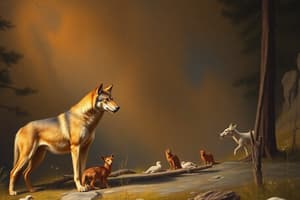Podcast
Questions and Answers
How does the removal of a top predator (level 4 organism) affect the trophic levels below it in a simple four-level trophic cascade?
How does the removal of a top predator (level 4 organism) affect the trophic levels below it in a simple four-level trophic cascade?
- Herbivore population decreases, leading to plant population increase.
- Omnivore Population increases, leading to herbivore population decreases
- Plant and herbivore populations both increase proportionally.
- Herbivore population increases, leading to a decrease in the plant population. (correct)
In a trophic cascade, the effects on lower trophic levels can only ever be positive (increase in population) or negative (decrease in population), but never neutral.
In a trophic cascade, the effects on lower trophic levels can only ever be positive (increase in population) or negative (decrease in population), but never neutral.
False (B)
Explain how an ecosystem engineer can act as a keystone species and initiate a trophic cascade, providing a specific example related to beavers.
Explain how an ecosystem engineer can act as a keystone species and initiate a trophic cascade, providing a specific example related to beavers.
Beavers, as ecosystem engineers, can modify habitats by building dams. These dams can lead to the creation of ponds and wetlands, altering plant communities, affecting fish and wildlife populations, and influencing water quality. This has cascading effects, impacting the entire ecosystem.
A trophic cascade involves a series of direct and ________ effects resulting from the addition or removal of species within an ecosystem.
A trophic cascade involves a series of direct and ________ effects resulting from the addition or removal of species within an ecosystem.
Match the following types of keystone species with their role in an ecosystem:
Match the following types of keystone species with their role in an ecosystem:
Flashcards
What is a keystone species?
What is a keystone species?
Species that has a disproportionately large effect on its environment relative to its abundance.
What are the types of keystone species?
What are the types of keystone species?
Predator, prey (herbivore), ecosystem engineer, mutualist, and plants.
What is a trophic cascade?
What is a trophic cascade?
A group of direct and indirect effects resulting from adding or removing species in an ecosystem.
Trophic cascade example: grass, grasshopper, frog, snake
Trophic cascade example: grass, grasshopper, frog, snake
Signup and view all the flashcards
Trophic cascade: plants, herbivores, omnivore, carnivores
Trophic cascade: plants, herbivores, omnivore, carnivores
Signup and view all the flashcards
Study Notes
- Notes about Trophic Cascades
Types of keystone species:
- Predator
- Prey (herbivore)
- Ecosystem engineer (beaver)
- Mutualist (bees)
- Plants
Trophic Cascade
- A group of direct and indirect effects, resulting former.
- Occurs when adding or removing species in an ecosystem.
Example 1
- Trophic levels involved: grass (1) -> grasshopper (2) -> frog (3) -> snake (4)
- The relationship between grass and grasshopper is positive.
- This is an indirect effect.
- The relationship between grasshopper and frog is positive.
- This is a direct effect.
- If you remove the frog, this makes a change.
Example 2
- Trophic levels involved: plant (1) -> herbivore (2) -> omnivore (3) -> carnivore (4)
- There is a positive relationship between plant and herbivore.
- This is an indirect effect.
- The relationship between herbivore and omnivore is positive.
- This has a direct effect.
- If you remove the omnivore, this makes a direct change.
Studying That Suits You
Use AI to generate personalized quizzes and flashcards to suit your learning preferences.




